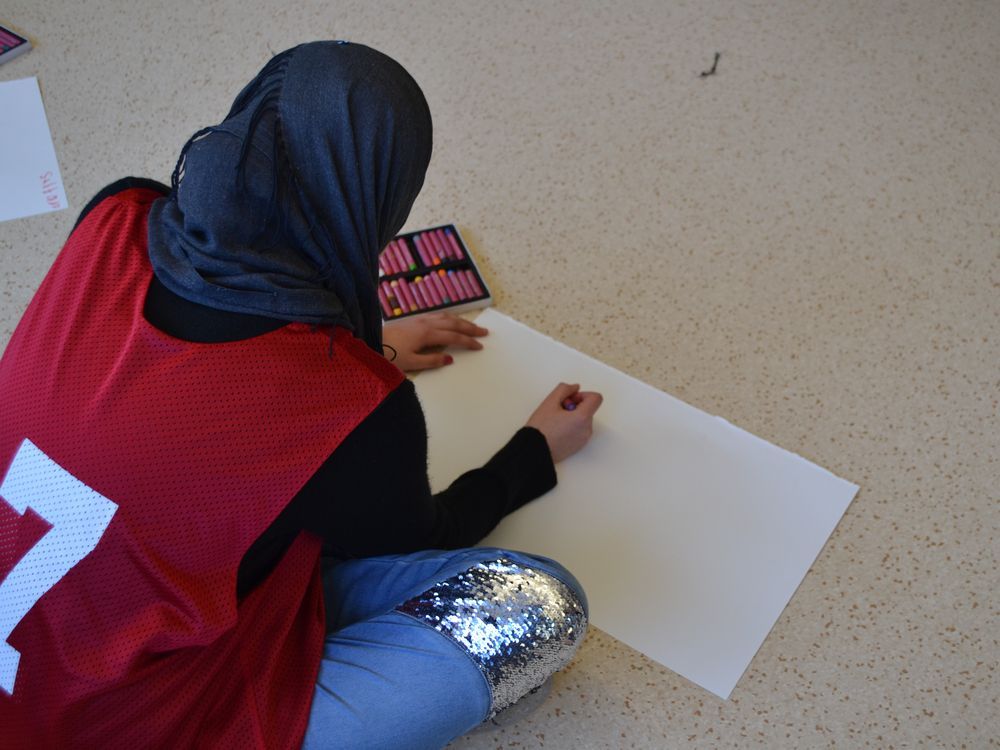Adopt-A-School: Booklet helps refugee students in Surrey

Credit to Author: Lora Grindlay| Date: Thu, 05 Dec 2019 22:53:53 +0000
It’s a sparsely written 24 pages, but if anyone wants to understand the trauma and bewilderment that child refugees bring with them to Canada, half an hour with “We Are Here Now” should do it.
This booklet found in Surrey school libraries contains 13 stories with illustrations by child storytellers, produced as a result of the school district’s Expressive Arts program.
The program uses visual art, creative writing, music, dance, plays, and is designed to offer release from the suppressed fears preventing these refugee children from coping with school.
“It’s a safe way for them to explore their experiences other than just talking about it,” says Peta Schur, an Expressive Arts therapist who has been working in Surrey since 2012.
The program is offered to small groups of child refugees in 13 elementary and secondary schools by seven therapists. They work with about 280 children a year.
“The number depends on funding. If we had more money, we could reach more children.”
Art classes in Surrey schools
The program is operated from the school district’s English Language Learning centre on King George Boulevard, and the Vancouver Sun’s Adopt-A-School program is being asked for $6,000 to help support it.
Schur said refugees can be expected to struggle at school under normal circumstances, considering they have to learn a new language, are living in a different culture with different customs and often living in poverty.
Some have never had formal schooling in their home countries, others had their education interrupted.
“Often these adjustments are hard and there are a lot of misconceptions people have about refugees. They think, ‘You are in Canada now, you are safe,’” so everything should be fine.
But they fail to understand that safe or not, there is still a longing for the country left behind, its language and culture, she says.
And when unresolved trauma is added to that, the result is devastating.
Schur has heard accounts of incidents no child should ever have been exposed to — murders, assassinations, disappearances of loved ones, flight and hiding — fully lived nightmares.
“These are things we can’t imagine. I worked with a seven-year-old child who kept repeatedly drawing the same picture. She was from Iraq and when she was four she was in the kitchen which looked out onto a back alley and she saw a neighbour being shot in the head.
“She screamed and her mother rushed in and held her down while this was going on, and she had never talked about it until she was in the group with other children.
“We had one child who talked about running away from the Taliban with her family, running through the mountains, living in a shelter built of stones and sticks. This happened when she was five or six. She was terrified.”
Kurdish refugees are now arriving from Syria and many of them are anxious about relatives they have left in Syria.
“There is one girl who was in a soccer stadium with her brother when soldiers arrived and started shooting people.”
In We Are Here Now, an Iraqi boy writes about the day his family were planning a party and “my big brother (who) was really nice and kind to me … went out to buy the bread.”
He never came back.
“He didn’t come home and we didn’t know where he was. In the morning, we went and we saw it…”
He had been killed by a bomb. Schur said once these children express their trauma, the effects are dramatic.
“Something shifts inside them. It settles them psychologically. They relax, they are more able to concentrate in class. You can see the physical relief. They’ve been holding on to this for so long that when they let go and say it, it allows them to be free of it.
“Now they can play and make friends and feel like they belong.”